You’ve started your seeds indoors, witnessed the magic that is germination, and watched your sprouts grow into lean, green little seedlings.
You think they’ll be ready to enter the world outside the confines of that warm, cozy bubble called your kitchen (or bathroom or greenhouse or wherever they’ve been shacking up) in a few weeks.
But like a good parent, you don’t want to set them out before preparing them for what it’ll really be like out there.
You need to harden them off first.
It sounds kind of gangsta, to harden off seedlings, but that’s exactly the attitude they’ll need when they make the transition from being indoor to outdoor plants.
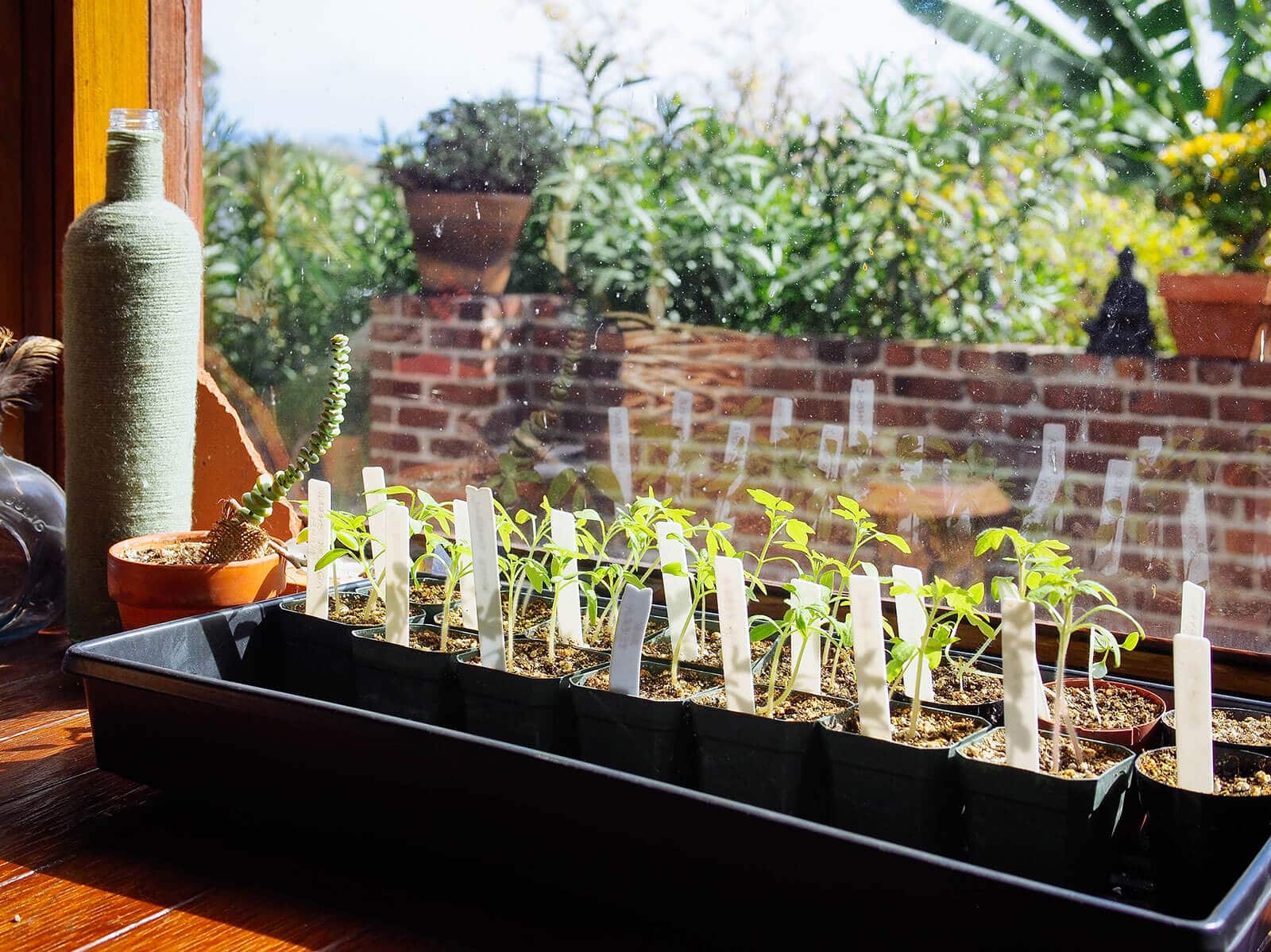
What does it mean to harden off seedlings?
Hardening off your seedlings is the vital step of acclimating them to the outdoors to assure their survival. You don’t want to transplant seedlings directly in the garden without “weaning” them first, and this goes for vegetables, herbs, and flowers.
Up until this point, your seedlings have been protected from wind, rain, cold, heat, and intense sunlight. They need to toughen up before you fling them into the deep end of the pool, so to speak.
Why? For this simple reason: All plants have a protective waxy coating on the leaves (called a cuticle) that repels water, reduces the rate of dehydration, and filters harmful ultraviolet light.
Seedlings that have been grown in controlled conditions indoors (in a sunny window, under grow lights, or in a greenhouse) haven’t fully developed the cuticle and need time to build up their “armor” against environmental disturbances.
By gradually exposing seedlings to the outside elements, you stimulate their natural defenses and give them time to adapt to their new environment.
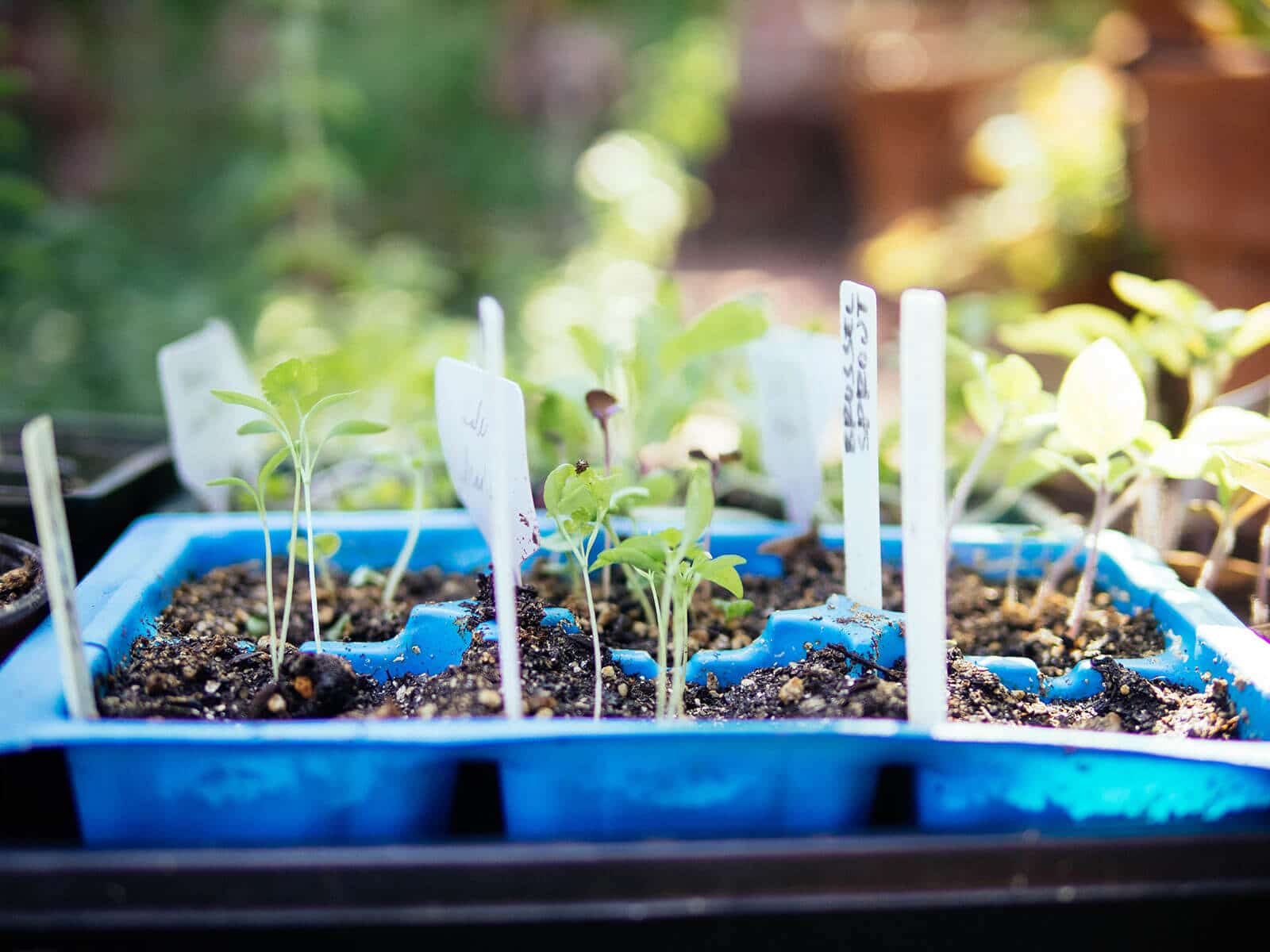
What happens if you don’t harden off plants?
Plants that were started indoors are susceptible to transplant shock and heat stress if they’re not hardened off properly.
If seedlings are left out in direct sun all day, their leaves could get scorched, curl under, or even fall off because they aren’t used to the intensity of unfiltered light.
Strong winds could weaken their stems (especially if you’re already dealing with leggy seedlings) or snap them in half.
Wide swings in temperature caused by hot days and cool nights could further stress delicate seedlings, and even if they do manage to survive, they could become more vulnerable to pests and diseases. Sudden cold temperatures, in particular, can even stunt seedling growth or kill them outright.
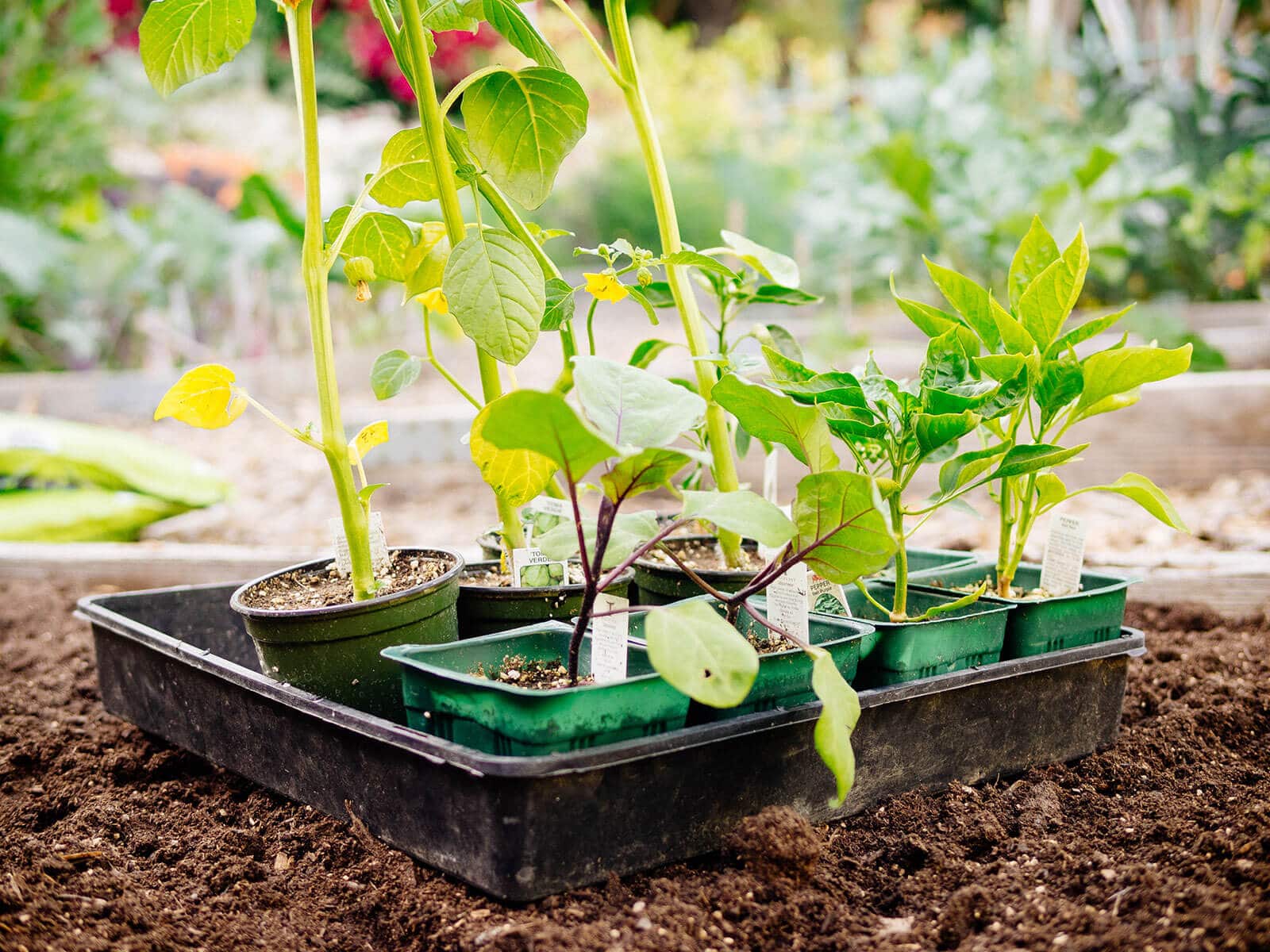
Do you need to harden off plants purchased from a nursery?
Nursery-grown seedlings usually start in greenhouses before moving outside. The commercial process of propagating, transplanting, packaging, and sometimes shipping them means they’re already adjusted to the outdoors by the time you buy them.
While nursery plants that are displayed in full sun don’t need to be hardened off, smaller seedlings that live under a shade structure are susceptible to shock if not hardened off properly. You’ll have the best chance at success if you harden off vegetables, herbs, and flowers before planting them in your garden.
In general, store-bought seedlings need less time to acclimate to the conditions in your yard. Set them out in dappled shade all day the first day, then full sun all day the second day, and finally overnight on the third day, making sure they have plenty of water every day.
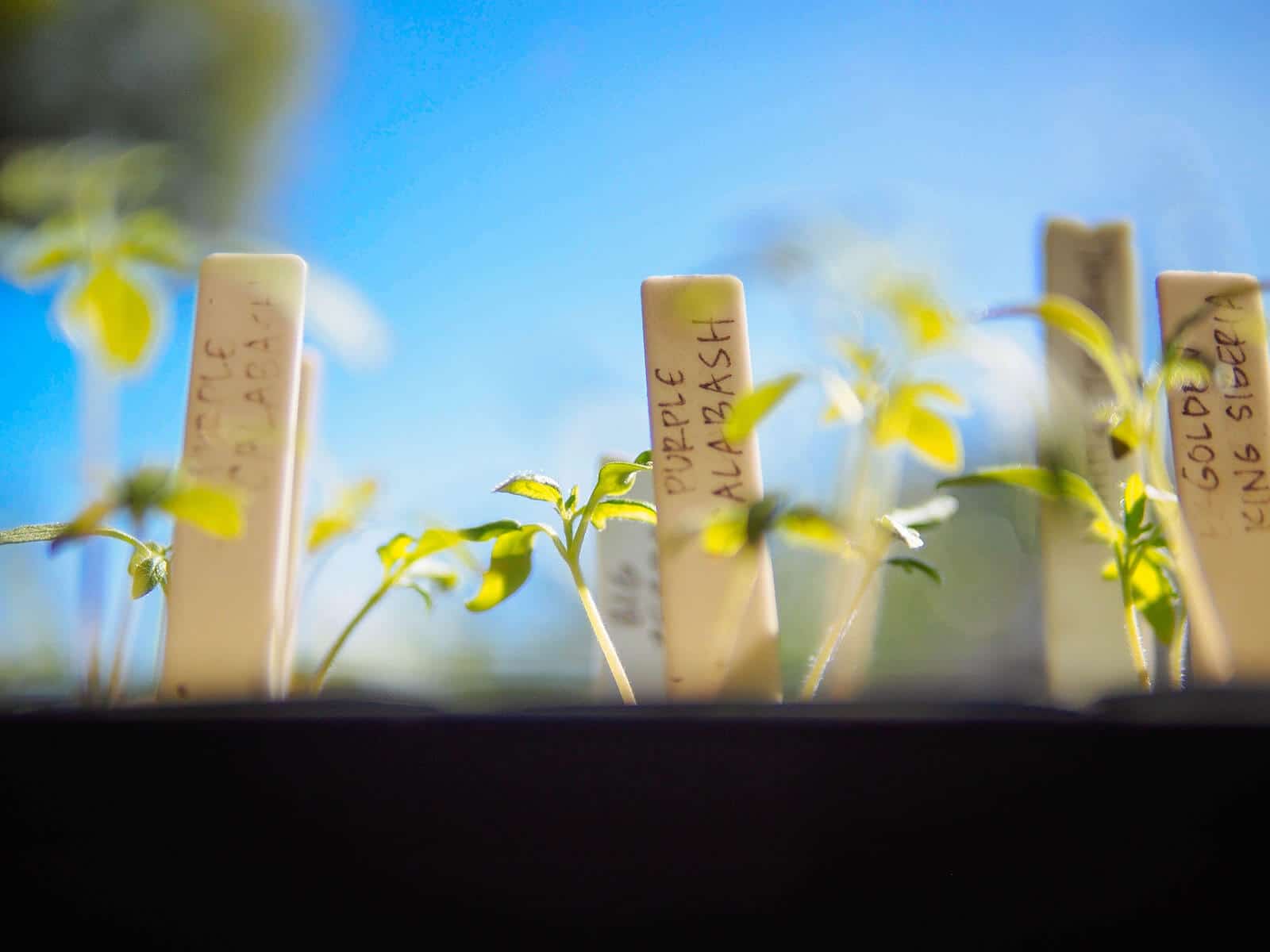
How long do you have to harden off plants?
In general, the process of hardening off will take about one week, and sometimes up to two weeks if the weather has an unexpected and dramatic drop in temperatures.
If your region has frost, you should time your seed starting in spring so the seedlings can start to go outside after the last frost date. (Use my planting calendar to get a custom sowing and transplanting schedule for your zip code.)
Wait until nighttime temperatures are consistently in the low 50°Fs before you start hardening off leafy greens and other cool-weather plants, or in the high 50°Fs for warm-weather plants like tomatoes, peppers, and squash.
In some cases you can start to harden off seedlings earlier, but they’ll need some kind of frost protection at night, like frost covers, cold frames, cloches, or unheated greenhouses.

How to harden off seedlings in 7 days
Day 0: Start hardening off seedlings when they’re a couple inches tall with their first set of true leaves.
That’s right: the process of hardening off seedlings should start indoors first.
Every day, as soon as your seeds germinate, brush your hand back and forth across the seedlings to simulate a breeze. This simple motion strengthens their stems and prepares them for the stronger breezes they’ll face in the garden.

Day 1: Set your seedlings outside in dappled or partial sun for 2 to 3 hours.
Make sure the area is free of wind and above 60°F. This could be under an eave, a covered porch, or a shady tree.
Give your seedlings only 2 to 3 hours of sun in the afternoon (the warmest part of the day) and be sure to check their moisture levels, as seedlings have a tendency to dry out quickly once they’re outside.
Bring them back inside for the night. The next few days is what I like to call the “spring shuffle” as your seedlings move in and out of the house.
Day 2: Set your seedlings outside in partial to full sun for 3 hours.
The next afternoon, put the seedlings outside for 3 hours in partial to full sun. Somewhere with a light breeze is also good for them at this point.
Be sure to watch the weather for any dramatic changes, and don’t forget to bring them back inside.

Day 3: Set your seedlings outside in full sun for 4 hours.
Put them someplace warm with a soft breeze, if possible, and make sure they don’t sit dry and wilted for a prolonged period of time.
Bring the seedlings inside for the night.
Day 4: Set your seedlings outside in full sun for 5 to 6 hours.
Bring them outdoors earlier in the day so they experience some cooler temperatures, and give them 5 to 6 full hours of direct sun.
Keep the potting soil moist, and bring the seedlings inside at the end of the day.
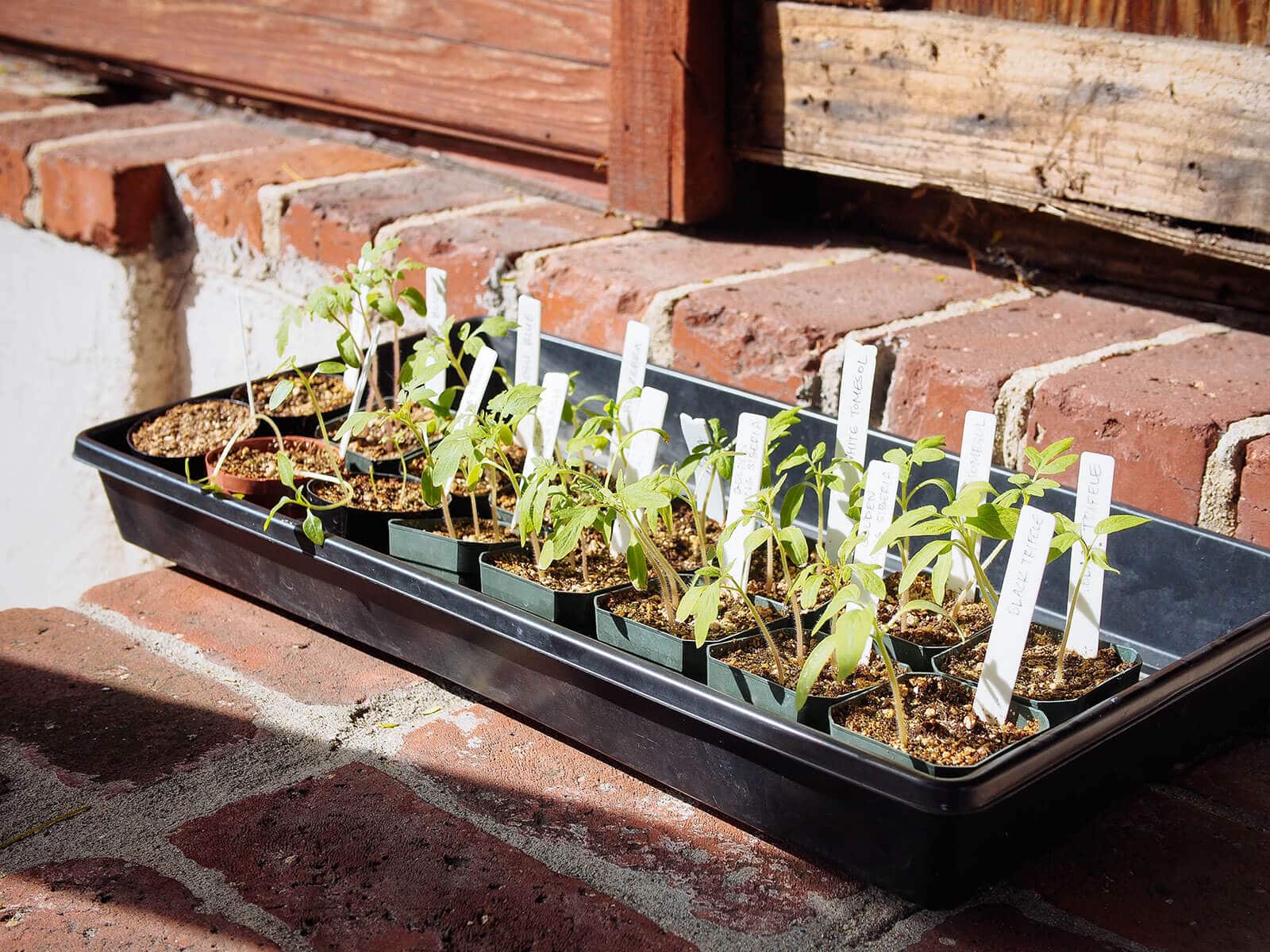
Day 5: Set your seedlings outside in full sun all day.
Leave your seedlings outside all day in the sun and the breeze. They’ll most likely need to be watered at least once if it’s a very warm day, so be sure to keep an eye on them.
Also — speaking from personal experience — you’ll want to watch for garden visitors that might think your seedlings are a free buffet. Squirrels, birds, and rabbits have a tendency to take a nibble if your seedlings are looking especially tasty.
Before it gets dark, bring the seedlings back inside.
Day 6: Set your seedlings outside all day and all night.
Today will be their first sleepover in the garden! Leave your seedlings outside in full sun and through the night as long as temperatures stay well above freezing.
It’s important to keep seedlings off the ground, as mice, voles, and other pests have an appetite for tender new growth and will be quick to decimate your seedlings overnight.
Day 7: Graduation day!
Your seedlings are hardened off and can be transplanted to their permanent location in the garden, whether it’s in soil or a larger container outside.
Your best chance at transplant success is on a cloudy day (to give seedlings time to adjust to yet another new environment), though at this stage, they should be able to take direct sun, spring rains, and gentle winds.
If frost is expected over the next week or two, be sure to protect your plants with frost cover. Unfortunately with hail and strong, cold winds, your plants can suffer damage, no matter how carefully you’ve hardened them off.
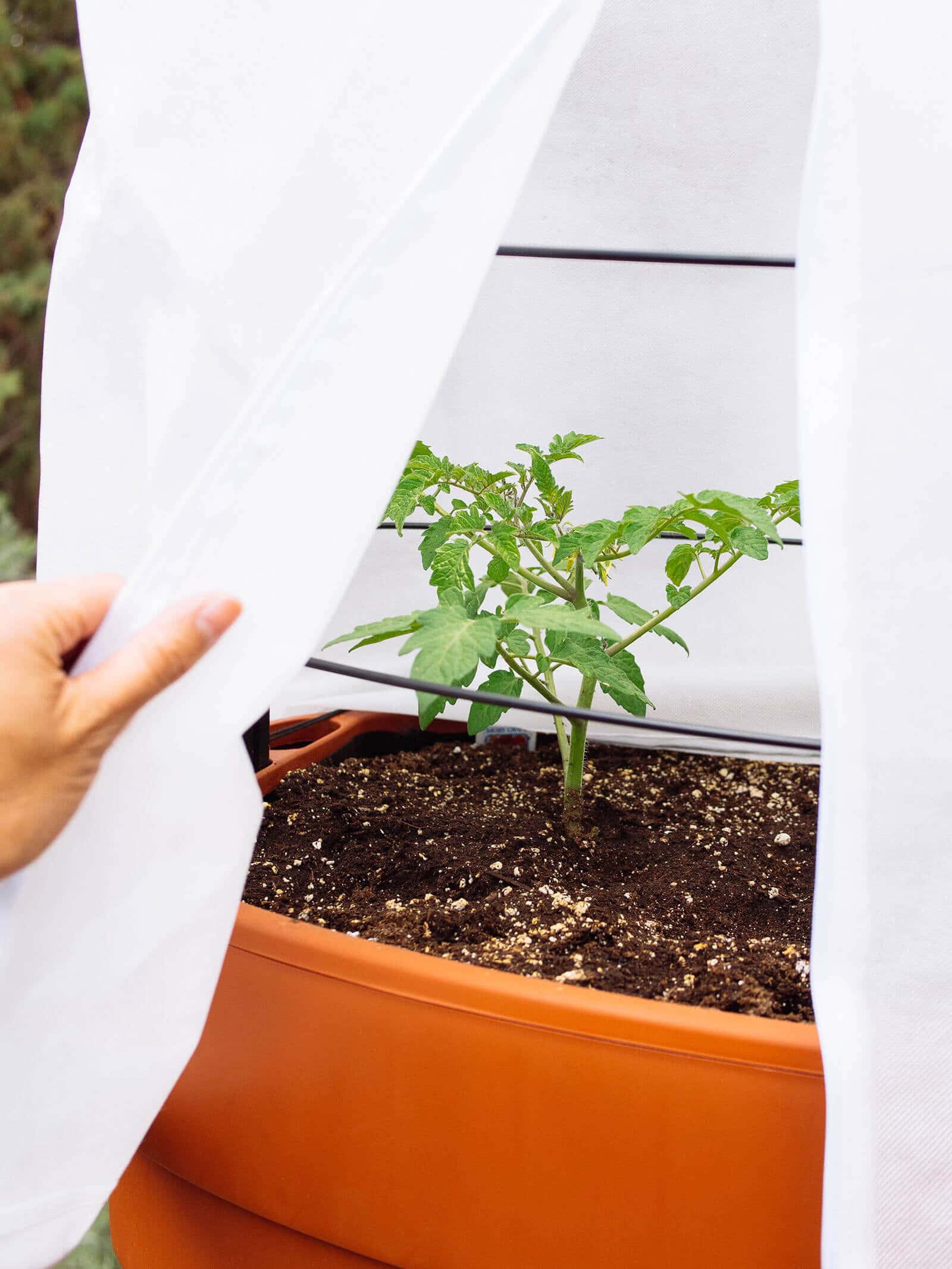
Disclosure: If you shop from my article or make a purchase through one of my links, I may receive commissions on some of the products I recommend.
How to harden off seedlings in less than 7 days with these garden shortcuts
Sometimes, you can shorten the amount of time it takes to harden off seedlings. I don’t recommend skipping this important step, but if you’re pressed for time or need to move those seedlings out of your kitchen stat, you can try one of these shortcuts.
Shortcut #1: Transplant your seedlings outside during a period of cloudy weather.
If the weather is on your side, with at least a week or two of mild, overcast days, you can plant your seedlings in the soil immediately.
This method is risky, especially for climates that have dramatic shifts between day and night (like we do here in Central Oregon) or higher elevations with blazing sun.
But if you live in a mild climate and are confident of your local weather patterns, you can save at least a week by transplanting your seedlings as soon as they have their first true leaves.

Shortcut #2: Use a portable “mini greenhouse” to protect your seedlings outside.
I’m a big fan of Wall-o-Waters, which look like water-filled teepees that you place around your plants. I’ve seen red versions and green versions, but they’re pretty much the same product and you’ll need one for each plant. (You can see them in action here when I grew tomatoes in containers.)
The Wall-o-Water collects heat from the sun during the day (while also protecting small seedlings from wind) and radiates the heat back out at night, keeping them snug and warm.
By the time the seedling outgrows the Wall-o-Water, it’s hardened off naturally — all without you doing the spring shuffle.
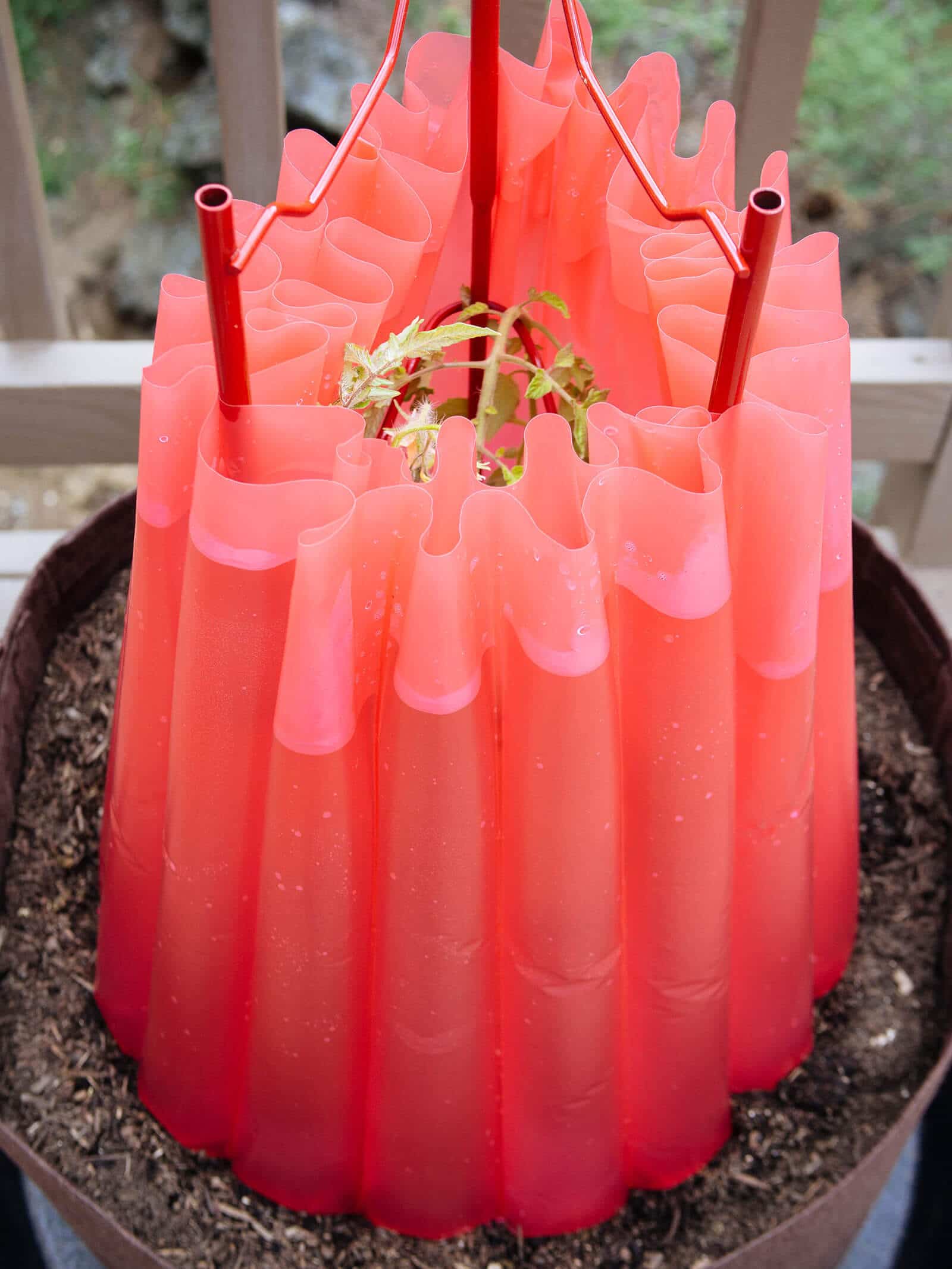
This post updated from an article that originally appeared on March 24, 2014.
View the Web Story on how to harden off your seedlings.
















What if you have a stretch of sunny days and cloudy days on the 6th or 7th day? Also, can you start hardening off cold tolerant seedlings before last frost date? Our daytime temperatures will be 10 C or higher but nights get down to 4 or 5 C, but my understanding is that lettuce, kale, broccoli, cabbage, and swiss chard (maybe also onion) can handle this?
Thanks!
I wish I read this before all my seedlings died. Oh well, next year!
I really enjoyed your blog post on how to harden off seedlings. I’m a new gardener, and I’m still learning a lot. This post was very helpful, and I’m sure it will be helpful to other new gardeners as well.
I especially appreciated the tips on how to gradually expose seedlings to the outdoors. I think this is a really important step, and it’s one that I would have overlooked if I hadn’t read your post.
I’m currently in the process of clearing out my backyard to make room for a garden, and I just rented a dumpster to help me get the job done. I’m excited to get started on my garden, and I’m sure I’ll be referring back to your blog post for more tips and advice.
Thanks for sharing your knowledge!
Thank you so much for this information. It is very helpful! Question…today I’m on Day 3. But, tomorrow, we have to leave for four days. Should I pick up with Day 4 when I return, or will I need to start from Day 1 again? I can put them out the late afternoon/evening if the day we return, so, in all, they’ll be missing three days of being outside. Thanks, in advance, for your advice!
You’ll have to start over with hardening off the seedlings, as they’ll have become accustomed to being inside all day/night again.
Hello! I love this article about hardening off seedlings in 7 days! Can you tell me how long after Day 0 when the seedlings have their first true leaves do you begin Day 1? Do you brush the leaves only one day and then move to Day 1? In other words, by the time the 7 days are over, how old are the seedlings at that time? It sounds like the seedlings would only be a few inches tall at that time when you begin the hardening off process. It would be great if I could start hardening them off that young! I have never done that before and didn’t think they could be hardened off that young. Thanks so much! 🙂
Seedlings only need to be hardened off before they go outside, and I recommend starting the process when the risk of frost has passed and your seedlings have developed a couple sets of true leaves. The age will vary by plant since they all grow at different rates.
Where did you get the red water wall spreader in the pic? I have never seen those but I NEED them! LOL
Thank you for this helpful information!
I use these: https://amzn.to/2Y4zRpn
I have around 3 dozen for my tomato and pepper plants! They work GREAT for keeping young plants warm early in the season.
Hi Linda ! We live in Central Oregon The weather has been wet and cloudy so far but this week looks like we can finally put our warm weather crop out. We started our seedlings in the greenhouse have not used the harding off process before talking my hubby into this year. Most our vegetables are in gallon contains so I wouldn’t call them seedlings. Should we still follow your process ?
*containers
Yes, always harden off your greenhouse plants before putting them outside. Otherwise the cold nights will shock them!
Question, I forgot to harden my plants and after three days ingrond, they have turned yellow and wilted. If I put them back in small pots and bring them inside, will they revive? And start the hardening process?
No, digging them back up will subject them to more transplant shock. I’d keep them covered and warm for a few nights (using frost cloth or a portable greenhouse-type tent) and continue watering. They should bounce back.
I had so many plants that moving them indoors and outdoors took a lot of time. I have two portable garden greenhouses I set up underneath my deck and gradually introduced the plants to the weather and at night closed it up to protect them from the weather. So far it seems to be working. The weather is the issue. In my area of Washington state it says you can plant cucumbers, squash, tomatoes, and Peppers after April 15th but many of my plants end up dying or just don’t grow. I’m trying to wait it out until May and hope they do better. Most all of my tomato and pepper plants are 1 1/2 feet tall already.
I have some sprouts that I’ve been so worried to move outside because it gets pretty hot here in Texas! I can’t wait to try your method! Thank you so much, this helps a lot!
Very informative! I just accidentally gave my seedlings what I believe is heat shock and a lot of them are very droopy and don’t look good at all ): they weren’t on for long but were in the sun and it’s very hot here today. Any advice on what to do? I brought them inside as soon as I noticed and gave them a nice gulp of water but I think I might of killed them, ugh.
I’ve done that a few times. At the very beginning, seedlings’ do not do well in direct sunlight.
Ever since I saw my baby plants ascending past the kitchen window in a windstorm, I gave up the dangerous hardening off process for my seedlings. Between wind, animals, forgetting them and having them burn up, etc, it just was too chancy. For years I just plant the plants with no hardening off. I protect them with split cedar shingles, pushed into the soil on the SouthEast and SouthWest side so that they will not get direct sun. If they are leggy, I add more of these thin boards on the other sides. This creates a shelter that protects the plants from wind and sun and to a certain extent from hail, driving rain, and even animals. Within a week or so I can check progress and start removing the protection, a little at a time, as determined by the conditions of the plant. I have several 5 gallon pails full of these stakes which I store and reuse every year. Works for me.
Trying Linda’s method this year. But probably going to do yours next year!! We’re just starting our new garden and dont have the plots quite ready for my 250 indoor plants quite yet (very large family) so spring shuffle it is!
Pretty good summary, but there’s a few things I’d like to add. Many plants go out before the last frost date, and must be started inside due to low germination rates in cold weather. Things like onions, lettuce, ect. Here in MN we swing 60 degrees on the worst days, from the 80s down to the 20s. A guy can easily fool himself with that weather. The other annoying extreme is a long string of cold rainy and overcast days. We just came out of a three week streak with virtually no sun. Spring 2019 we had 18″ of snow on April 15, then a month of cloudy weather. No sun means no warm soil. Didn’t dry out till June. Killed a couple hundred dollars of bare root stuff that year. The bottom line is, there is weather that can drown your little guys into oblivion.
Good information, one question though do we need to soak seeds before planting?
Soaking speeds up germination, but if you’re good about keeping your planting medium (and therefore your seeds) moist, you don’t need to soak them ahead of time. I never do.
Thanks Linda, love your website & advantures.
There are some seeds you should not soak because they might rot after planted. One example is black kabouli garbanzo beans. I soaked them one year because they seemed like they should be soaked and about 30% rotted turning to mush
Started seeds indoors? Here’s how to toughen them up for the outdoors. How to Harden Off Your Seedlings http://t.co/N3ZhWADBew #gardenchat
do you burp them as well……………. LOL
This is so informative, thanks for all the great tips!
You’re welcome! Happy spring!